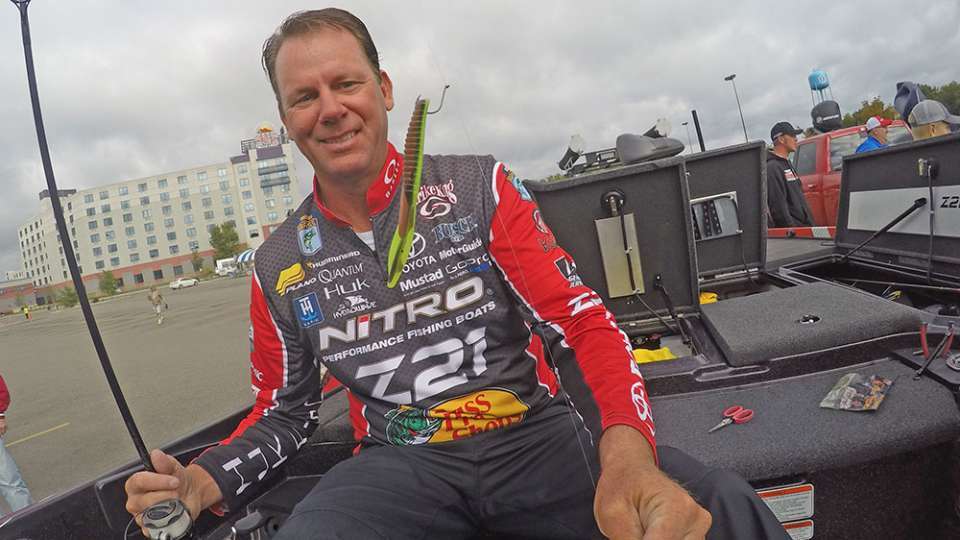
The power of the drop-shot rig is no secret to any serious basser.
It has played everywhere the Bassmaster Elite Series has gone, from the California Delta to Florida’s Lake Okeechobee to the northern Great Lakes.
I’ve used it for largemouth and smallmouth, in dirty and clear water and shallow and deep.
What makes it so effective is you can keep a bait off the bottom and imitate whatever the bass are feeding on.
But to be totally effective, you have to consider rigging techniques that give you the best chance of fooling bass in various situations.
Water depth and cover are keys to determining the leader distance between my hook and weight and how I rig the lure.
The distance between the sinker and hook is determined by how far off the bottom the fish are positioned and whether I’m fishing vertically or casting the rig.
When casting a drop shot, especially in deeper water, remember that the angle of the line entering the water will affect how far the bait is off bottom. For example, if you have an 18-inch leader and casting into 10 feet of water, your bait is only 4 or 5 inches off the bottom.
Also, when bass in northern lakes are keying on crawfish, I use a very short leader because the fish are feeding near the bottom. The bait still has good action there because of tension I maintain as the sinker moves on the bottom.
When casting for smallmouth in real clear water, I may use a longer leader to get the bait higher where it’s visible to more fish. That was real important for me when I won on the St. Lawrence River this year.
Bait styles matter, too. I generally prefer baits without a lot of swimming legs or appendages, like the Strike King Dream Shot. It’s very soft with a flat side and a unique tail that imparts a lot of quiver and action with very subtle movements. There are times you don’t have to shake or move it; the natural currents in the water will make the bait undulate and trigger neutral bass into striking.
I prefer to nose hook it with a drop-shot hook, but it can be deadly by wacky rigging it in the middle of the bait. If I have snaggy cover around, I will rig it weedless with a 1/0 or 2/0 Mustad Grip Pin Hook.
The Half Shell is another choice. It’s a smaller lure with similar characteristics except has a beefy, stiffer body so that it swims and darts when you hop or shake it.
Weight size and style is another consideration. When fishing hard or clean bottoms, I like the Strike King Tungsten weight because I can feel it better and the density of tungsten will “click” when bouncing over rocks or shells. That can attract fish. It also allows me to use a smaller sinker and still get an ideal sink rate.
When fishing vegetation, I prefer the pencil-style drop-shot weights that come through grass better.
When choosing weight size, use enough to gain good tension but not so much it hangs up in cover or feels like a bowling ball rolling on the bottom. That was important at the St. Lawrence River, where I kept adjusting the weight until I found one that drifted naturally and tickled the bottom.
Like most anglers, I use small diameter braid and a fluorocarbon leader for drop shotting, but not always. When fishing super clear water and in vertical presentations, I prefer straight fluorocarbon because of the line’s limited visibility. One exception would be in heavy current, where the smaller braid creates less drag.
In most cases, I use 8-pound Bass Pro Shops XPS fluorocarbon as a main line or as a leader. To reduce line twist, I add a Mustad No. 12 black barrel swivel about 2 or 3 feet between the main line and the leader. It makes a huge difference.
And finally, don’t be afraid to fish heavier line and bigger baits when fishing shallow cover. I’ve used 20-pound line and big plastics for flipping which offers a different presentation than those anglers who are using more traditional flipping techniques.
Remember, it’s all about the attitude!
Kevin VanDam’s column appears weekly on Bassmaster.com. You can also find him on Facebook, Twitter and Instagram.

